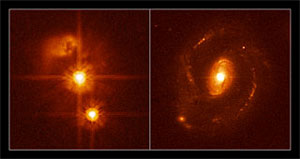University of Pittsburgh researchers first to report function of tunneling nanotubules
Immune system cells are connected to each other by an extensive network of tiny tunnels that, like a building’s hidden pneumatic tube system, are used to shoot signals to distant cells. This surprising discovery, being reported by two University of Pittsburgh School of Medicine researchers in the September issue of the journal Immunity, may explain how an immune response can be so exquisit
Computers can predict the detailed structure of small proteins nearly as well as experimental methods, at least some of the time, according to new studies by Howard Hughes Medical Institute researchers.
The findings, which were reported in the September 16, 2005, issue of the journal Science, provide a glimmer of hope that scientists eventually may be able to determine the structure of proteins from their genomic sequences, a problem that has seemed insurmountable.
An international team of 53 researchers has offered the most convincing evidence so far linking bipolar disorder, also known as manic depression, to two chromosomal regions in the human genome. The finding gives scientists refined targets for further gene studies.
“Even though bipolar disorder affects millions of people around the world-sometimes throughout their lifetimes-what we understand to be biologically relevant at the genetic level is not terribly characterized,” said Matth
Hurricane search and rescue is one of first domestic uses of such vehicles
Providing the benefits of speed, portability and access, a pair of unmanned aerial vehicles (UAVs) surveyed storm-damaged communities in Miss. as part of the search for trapped survivors of Hurricane Katrina.
In what is one of the first deployments of such craft for disaster search and rescue, the vehicles captured video imagery to help responders focus efforts and avoid hazards.
“Th
The radioactive carbon-14 produced by above-ground nuclear testing in the 1950s and 1960s is providing forensic scientists with a more precise way to determine a person’s age at the time of death. The method could help in the identification of victims of Hurricane Katrina and other large-scale disasters.
The new technique, developed by researchers at Lawrence Livermore National Laboratory (LLNL) and the Karolinska Institute in Sweden, determines the amount of carbon-14 in tooth ena

The detection of a super massive black hole without a massive host galaxy is the surprising result from a large Hubble and VLT study of quasars. This is the first convincing discovery of such an object. One intriguing explanation is that the host galaxy may be made almost exclusively of dark matter.
A team of European astronomers has used two of the most powerful astronomical facilities available, the NASA/ESA Hubble Space Telescope and the ESO Very Large Telescope (VLT) at Cerro